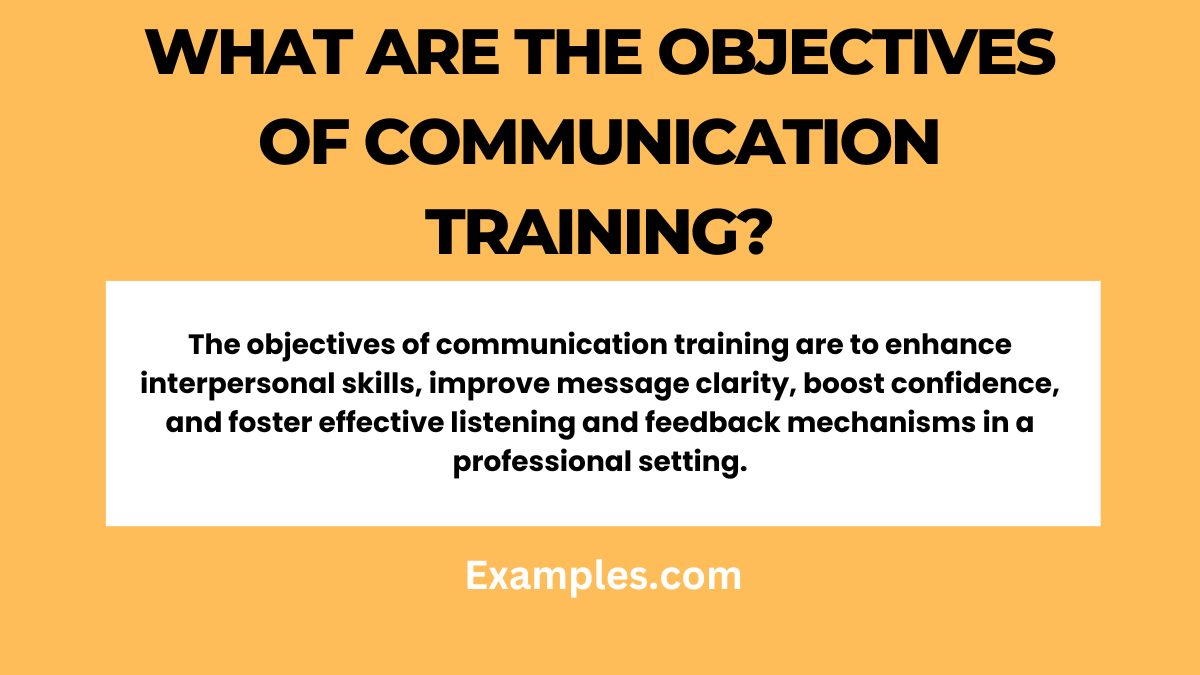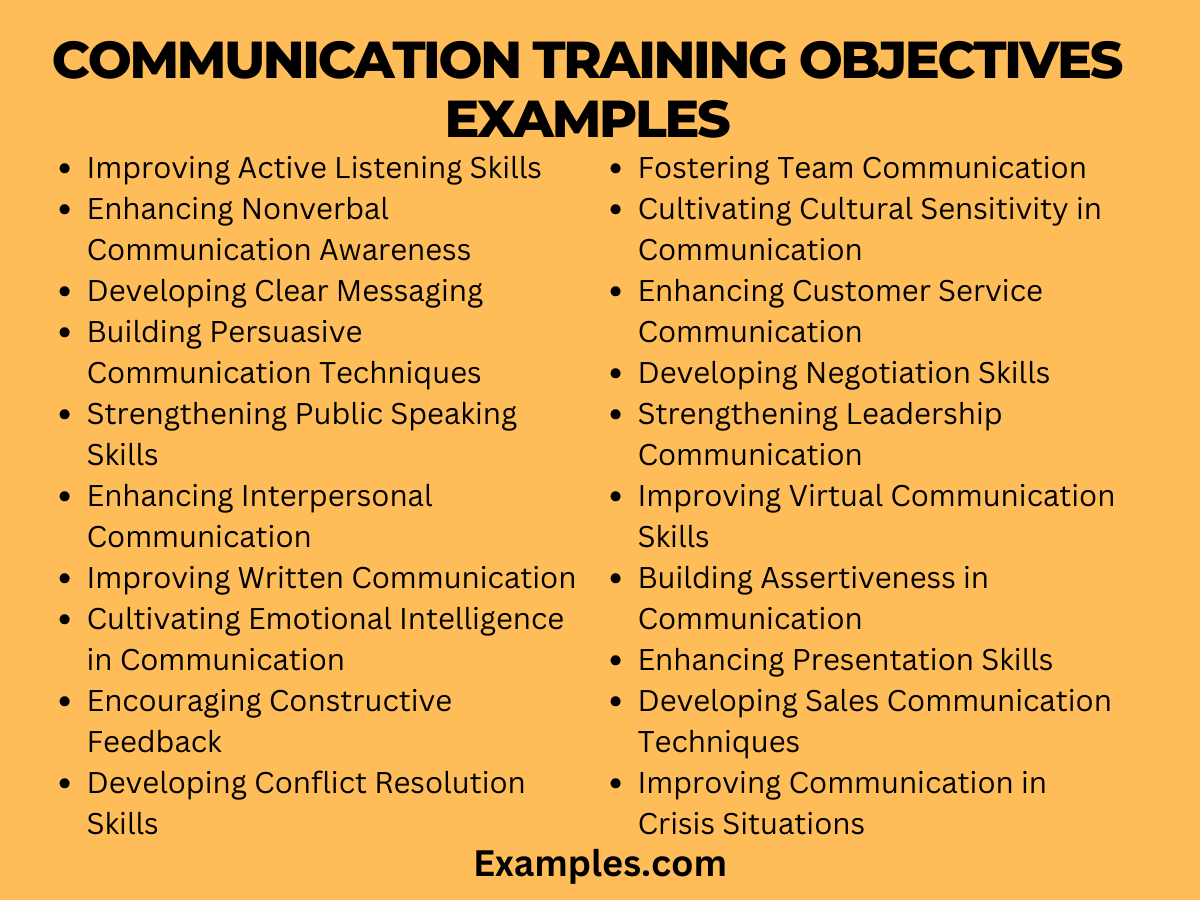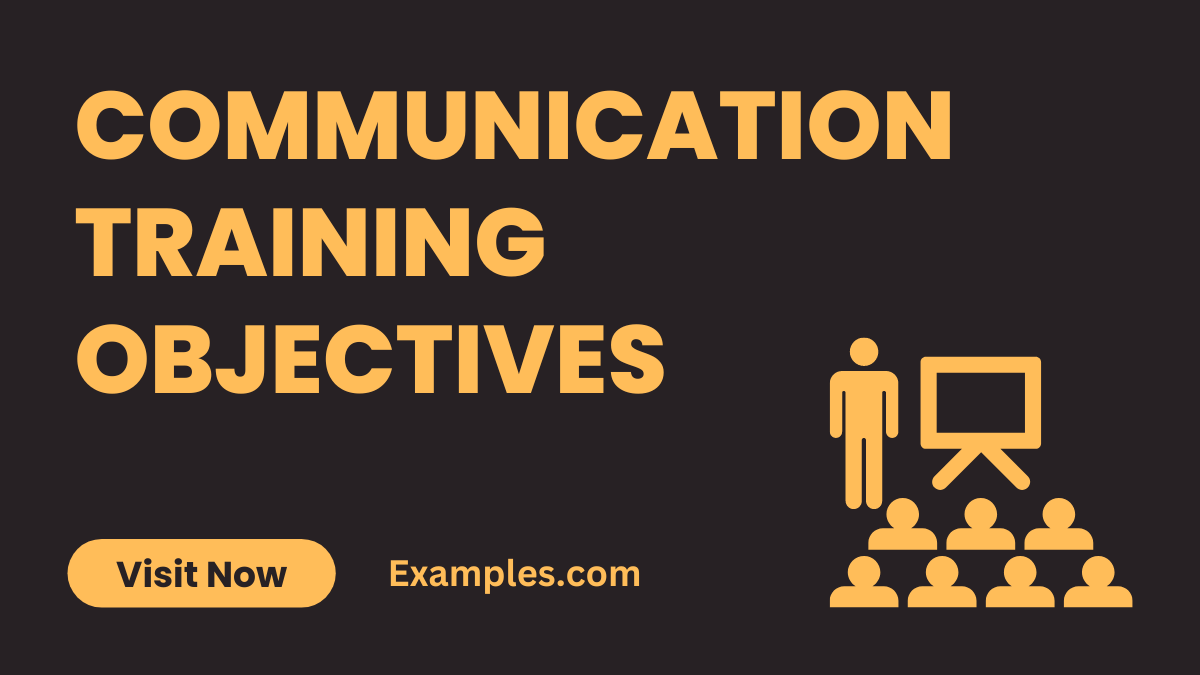29+ Communication Training Objectives Examples
Begin your path to enhanced communication with our detailed guide on Communication Training Objectives. This guide, enriched with practical Communication Objective Examples, is tailored to assist educators, professionals, and students in developing and refining their communication skills. It offers a wealth of knowledge and examples, focusing on effective techniques and strategies to improve interaction and understanding in various environments. Embrace this guide as your key resource for excelling in effective communication practices.
What are the Objectives of Communication Training?

The Objectives of Communication Training involve developing the skills and abilities needed for effective communication in various settings. This training aims to enhance understanding, clarity, and the effectiveness of interpersonal interactions. Key objectives include improving listening skills, verbal and nonverbal communication, and the ability to convey messages clearly and persuasively. In professional contexts, such as business communication or educational communication, these objectives are crucial for successful collaboration, negotiation, and leadership. Essentially, communication training helps individuals and teams communicate more effectively, fostering better relationships and outcomes.
30 Communication Training Objectives Examples
In today’s interconnected world, effective communication is essential. Our compilation of 30 Communication Training Objectives Examples provides a diverse range of goals to enhance communication skills in various domains. From improving employee communication in businesses to fostering effective dialogue in educational settings, these examples cater to different needs. Each objective is accompanied by a brief explanation and a practical communication example, illustrating how these objectives can be applied in real-world situations.

- Improving Active Listening Skills: Enhances understanding and response to verbal communication.
Example: “Let’s focus on active listening by summarizing key points after discussions to ensure we’ve understood correctly.” - Enhancing Nonverbal Communication Awareness: Increases understanding of body language and tone.
Example: “We will train to read nonverbal cues, like facial expressions, to better interpret messages.” - Developing Clear Messaging: Focuses on conveying ideas succinctly and effectively.
Example: “Our goal is to communicate ideas clearly, using simple language and avoiding jargon.” - Building Persuasive Communication Techniques: Enhances the ability to influence and motivate others.
Example: “We’ll practice persuasive techniques by presenting arguments with logical reasoning and emotional appeal.” - Strengthening Public Speaking Skills: Boosts confidence and effectiveness in speaking to groups.
Example: “To improve public speaking, let’s practice speeches with a focus on voice modulation and eye contact.” - Enhancing Interpersonal Communication: Aims at improving one-on-one interactions.
Example: “Our objective is to enhance interpersonal skills by engaging in empathetic and open-ended conversations.” - Improving Written Communication: Focuses on clarity and conciseness in written formats.
Example: “Let’s work on crafting concise emails with clear action items for recipients.” - Cultivating Emotional Intelligence in Communication: Enhances understanding and management of emotions in communication.
Example: “We will learn to recognize our emotional responses and communicate feelings effectively.” - Encouraging Constructive Feedback: Develops skills in giving and receiving feedback positively.
Example: “Our aim is to offer constructive feedback that is specific, actionable, and balanced.” - Developing Conflict Resolution Skills: Focuses on resolving disagreements amicably and effectively.
Example: “In conflict situations, let’s aim to communicate openly, seeking mutual understanding and solutions.” - Fostering Team Communication: Enhances group interaction and collaboration.
Example: “We will practice regular team meetings to enhance our group communication dynamics.” - Cultivating Cultural Sensitivity in Communication: Increases awareness and respect for cultural differences in communication.
Example: “Our training will include understanding diverse cultural communication styles to foster inclusivity.” - Enhancing Customer Service Communication: Aims at improving interaction with customers.
Example: “Let’s focus on active listening and empathetic responses to enhance customer service experiences.” - Developing Negotiation Skills: Improves the ability to negotiate effectively and reach agreements.
Example: “Our objective is to practice negotiation tactics that focus on win-win outcomes.” - Strengthening Leadership Communication: Aims at improving leaders’ communication with teams.
Example: “As leaders, we will work on transparent and inspiring communication to motivate our teams.” - Improving Virtual Communication Skills: Focuses on effective communication in remote settings.
Example: “We’ll learn best practices for virtual meetings, like clear agendas and active participation.” - Building Assertiveness in Communication: Develops the ability to express oneself confidently and respectfully.
Example: “Our goal is to communicate our needs assertively without overshadowing others’ opinions.” - Enhancing Presentation Skills: Improves the ability to deliver engaging and informative presentations.
Example: “Let’s focus on creating presentations with compelling visuals and clear messages.” - Developing Sales Communication Techniques: Aims at effective communication for sales success.
Example: “We will practice tailoring our sales pitches to address the specific needs of clients.” - Improving Communication in Crisis Situations: Focuses on clear and calm communication during emergencies.
Example: “In crisis scenarios, our aim is to communicate key information swiftly and clearly.” - Cultivating Storytelling Skills: Enhances the ability to use storytelling in communication.
Example: “Let’s incorporate storytelling to make our messages more relatable and memorable.” - Fostering Effective Email Communication: Aims at writing clear and purposeful emails.
Example: “Our objective is to write emails with a clear subject line and a concise body.” - Enhancing Listening for Understanding: Focuses on truly understanding the speaker’s message.
Example: “We’ll practice listening without interrupting and asking clarifying questions.” - Building Effective Communication in Teams: Aims at fostering open and collaborative team interactions.
Example: “Let’s create an environment where every team member feels heard and valued.” - Developing Communication Adaptability: Enhances the ability to communicate across various contexts.
Example: “Our training will focus on adapting our communication style to different situations.” - Improving Patient Communication in Healthcare: Focuses on empathetic communication with patients.
Example: “In healthcare, we’ll work on explaining medical terms in an accessible way to patients.” - Building Transparency in Organizational Communication: Aims at open and honest communication within organizations.
Example: “We will strive for transparent communication about organizational changes and decisions.” - Developing Communication Strategies for Marketing: Aims at crafting effective marketing messages.
Example: “Let’s focus on creating marketing communication that resonates with our target audience.” - Enhancing Communication for Customer Retention: Focuses on communication that fosters customer loyalty.
Example: “Our objective is to keep in regular contact with customers, offering personalized solutions.” - Improving Communication for Employee Onboarding: Enhances the onboarding experience through clear communication.
Example: “We will ensure new employees receive all necessary information in an understandable format.”
Each of these objectives highlights the versatile and vital role of communication training across different sectors, emphasizing its significance in achieving professional and personal growth.
What are the Objectives of Effective Communication Training?
The primary objective of effective communication training is to enhance clarity and comprehension in interpersonal interactions. This training aims to develop skills that enable individuals to convey their messages in a clear, concise, and understandable manner, whether in business communication or personal conversations. It’s about ensuring that the intended message is not only delivered but also received and understood as intended.
Building Persuasive and Influential Communication Skills
Another key objective is to equip individuals with the skills to be persuasive and influential in their communication. This aspect is particularly significant in contexts like sales enhancement communication objectives or leadership communication objectives, where the ability to inspire, motivate, and persuade can lead to more effective leadership and better business outcomes.
Fostering Effective Listening and Feedback
Effective communication training also focuses on enhancing listening skills and the ability to provide and receive feedback constructively. In environments where feedback generation communication objectives are essential, such as in employee training or therapy, developing these skills is crucial for growth and improvement.
Adapting to Various Communication Styles
Adaptability to various communication styles and environments, such as digital marketing communication or internal communication in organizations, is another important objective. This flexibility ensures effective communication across different platforms and with diverse audiences.
Communication Training Objectives for Teachers
For teachers, communication training objectives often include developing the ability to facilitate engaging and inclusive classroom communication. This goal is vital in educational communication objectives, where the focus is on creating a learning environment that encourages student participation and caters to diverse learning styles.
Enhancing Student Understanding and Engagement
Improving the ability to convey complex information in a way that enhances student understanding and engagement is another key objective. In this regard, teachers work towards breaking down difficult concepts into simpler terms, using communication objectives examples and interactive teaching methods.
Building Effective Parent-Teacher Communication
Communication training for teachers also involves developing effective parent-teacher communication strategies. This aspect is crucial in building a supportive educational community and involves being able to clearly convey student progress, communication objectives in education, and any concerns or achievements.
Developing Conflict Resolution Skills
Lastly, an important objective for teachers is developing conflict resolution skills. This skill is essential in managing classroom dynamics and ensuring a positive and respectful learning environment. It involves being adept at addressing and resolving misunderstandings or disagreements in a constructive manner.
In summary, communication training objectives vary depending on the specific roles and contexts, but they all aim towards enhancing the effectiveness and efficiency of communication. Whether for teachers, professionals, or individuals looking to improve their personal communication skills, these objectives are foundational in achieving successful and meaningful interactions.
Communication Training Objectives for Students
For students, communication training objectives focus on enhancing both academic and personal communication skills. This training is pivotal in developing the ability to articulate thoughts clearly, participate in academic discussions effectively, and engage in meaningful conversations with peers. It plays a crucial role in educational communication objectives, where the goal is to foster a strong foundation in communication that benefits students both in and out of the classroom.
Developing Presentation and Public Speaking Abilities
A significant objective for student communication training is developing presentation and public speaking abilities. This skill is essential not just for academic success but also for personal growth and future career opportunities. It involves training students in leadership communication objectives and audience engagement communication objectives, preparing them to present confidently and engage audiences effectively.
Cultivating Collaborative Communication for Teamwork
Another key focus is cultivating collaborative communication skills necessary for effective teamwork. This aspect is integral in project-based learning environments and group activities, where students must learn to communicate, collaborate, and resolve conflicts within a team setting, aligning with project communication objectives and teamwork communication strategies.
Building Empathy and Cultural Sensitivity
Communication training for students also aims to build empathy and cultural sensitivity. In an increasingly diverse world, understanding and respecting different perspectives and communication styles is vital. This training aligns with stakeholder trust building communication objectives, enhancing students’ ability to interact respectfully and empathetically with diverse groups.
Communication Training Objectives for Employees
For employees, communication training objectives often include improving workplace communication and collaboration. Effective internal communication is crucial in business communication objectives, where the goal is to enhance productivity, foster team spirit, and streamline workflow through clear and efficient communication.
Enhancing Customer Service and Client Interaction Skills
Enhancing customer service and client interaction skills is another primary objective of communication training for employees. This focus is particularly important in roles that involve direct customer interaction, where employees need to develop skills aligned with customer relationship communication objectives and feedback generation communication objectives.
Developing Leadership and Managerial Communication
Developing leadership and managerial communication is a key objective for employees in supervisory roles. Effective leadership communication involves being able to motivate, guide, and inspire teams, which is essential in achieving leadership communication objectives and employee motivation communication objectives.
Adapting to Digital Communication Platforms
In the current digital age, an important objective is adapting to various digital communication platforms. This training is crucial for employees to effectively use tools like email, social media, and virtual meeting software, aligning with digital marketing communication objectives and virtual team communication strategies.
In conclusion, communication training objectives play a significant role in enhancing the communication skills of students and employees alike. For students, the focus is on academic success, personal growth, and preparation for future challenges. For employees, the objectives are geared towards improving workplace efficiency, customer relations, leadership abilities, and adapting to the digital communication landscape. Both sets of objectives aim to equip individuals with the necessary skills for effective and successful communication in various contexts.
Our guide on Communication Training Objectives offers vital insights into developing effective communication skills, tailored for both students and employees. These objectives are crucial for academic success, professional growth, and personal development. By focusing on clear, strategic communication goals, individuals can significantly enhance their interaction capabilities, leading to more successful and fulfilling academic, personal, and professional journeys.



